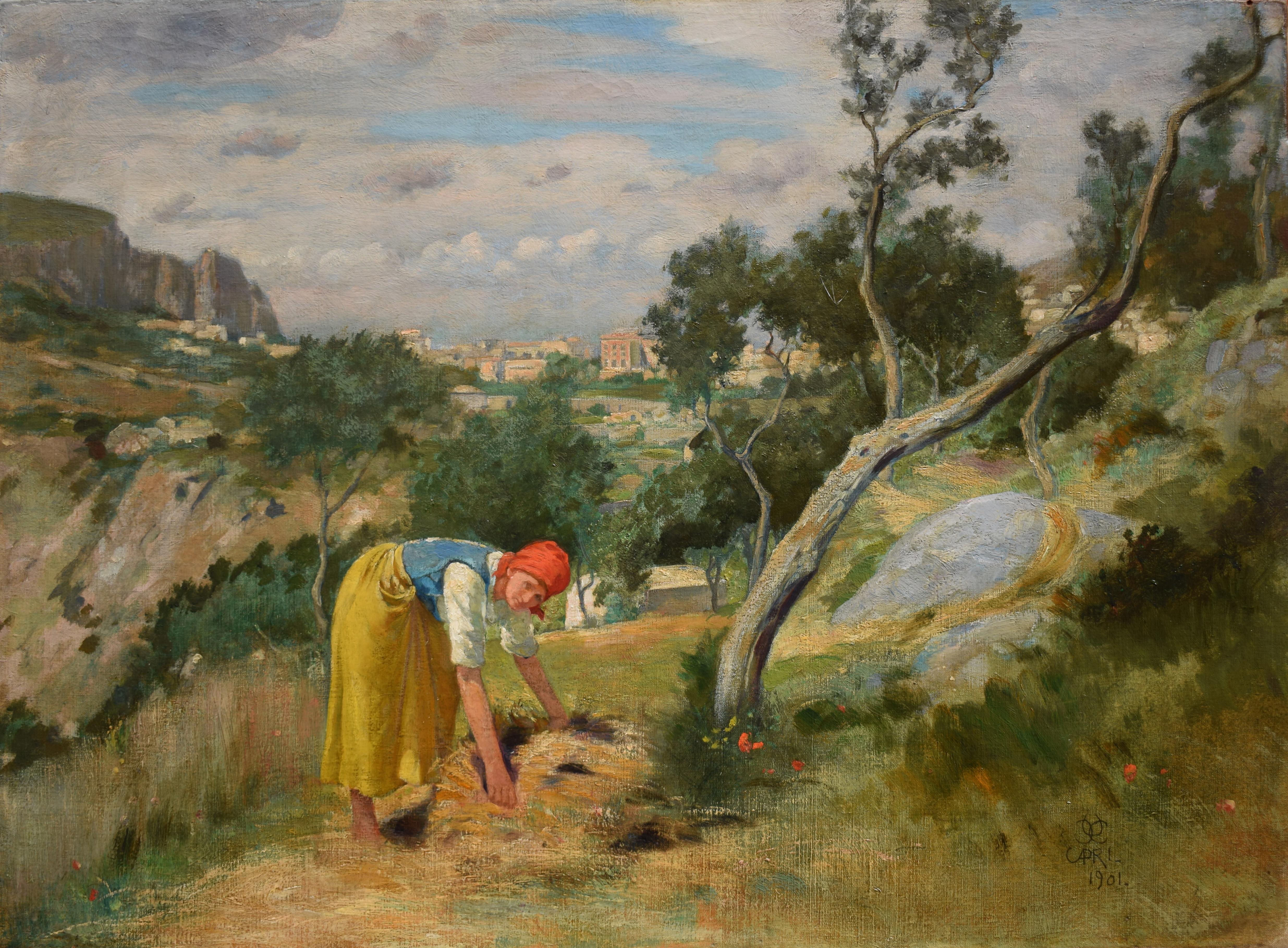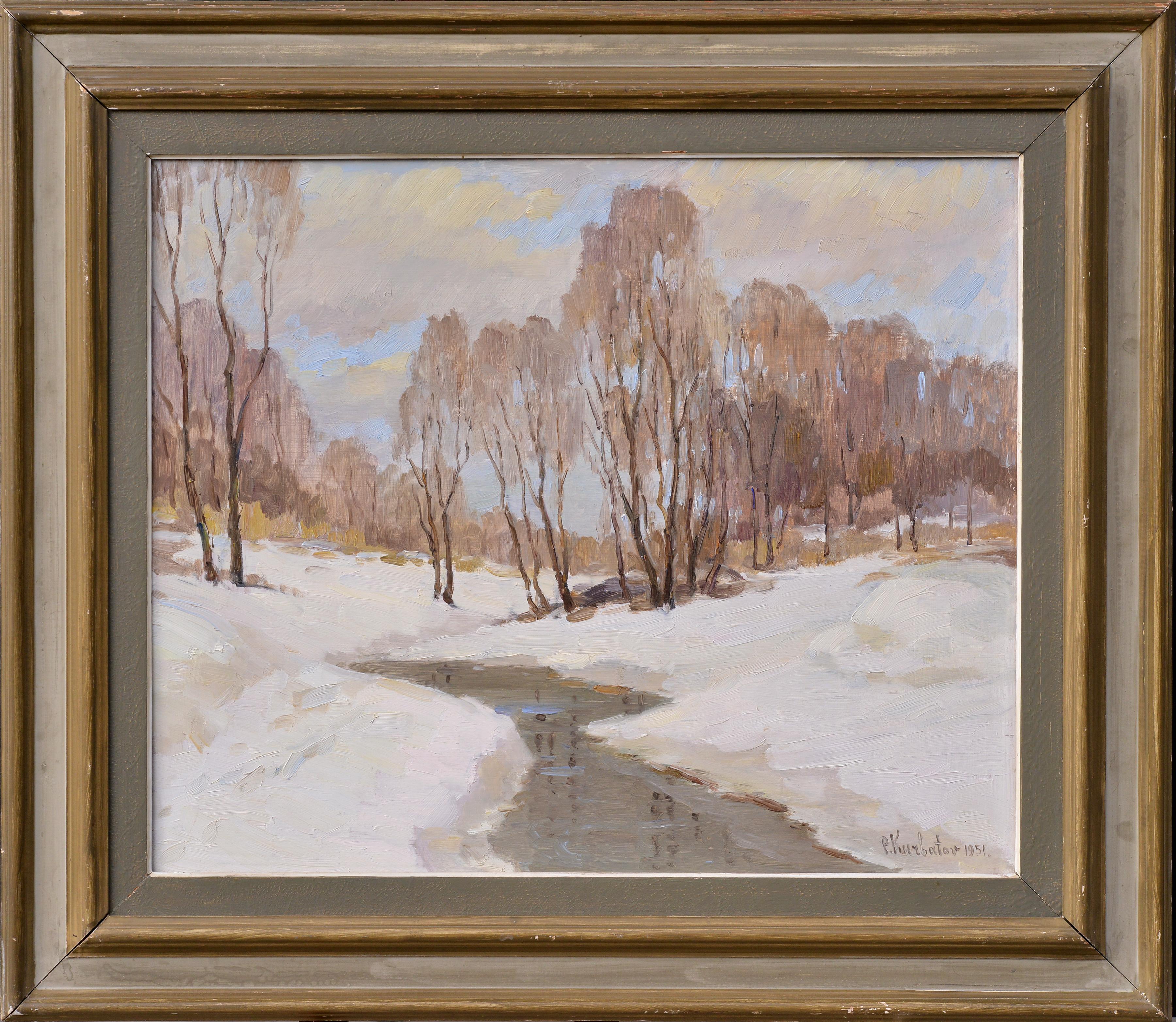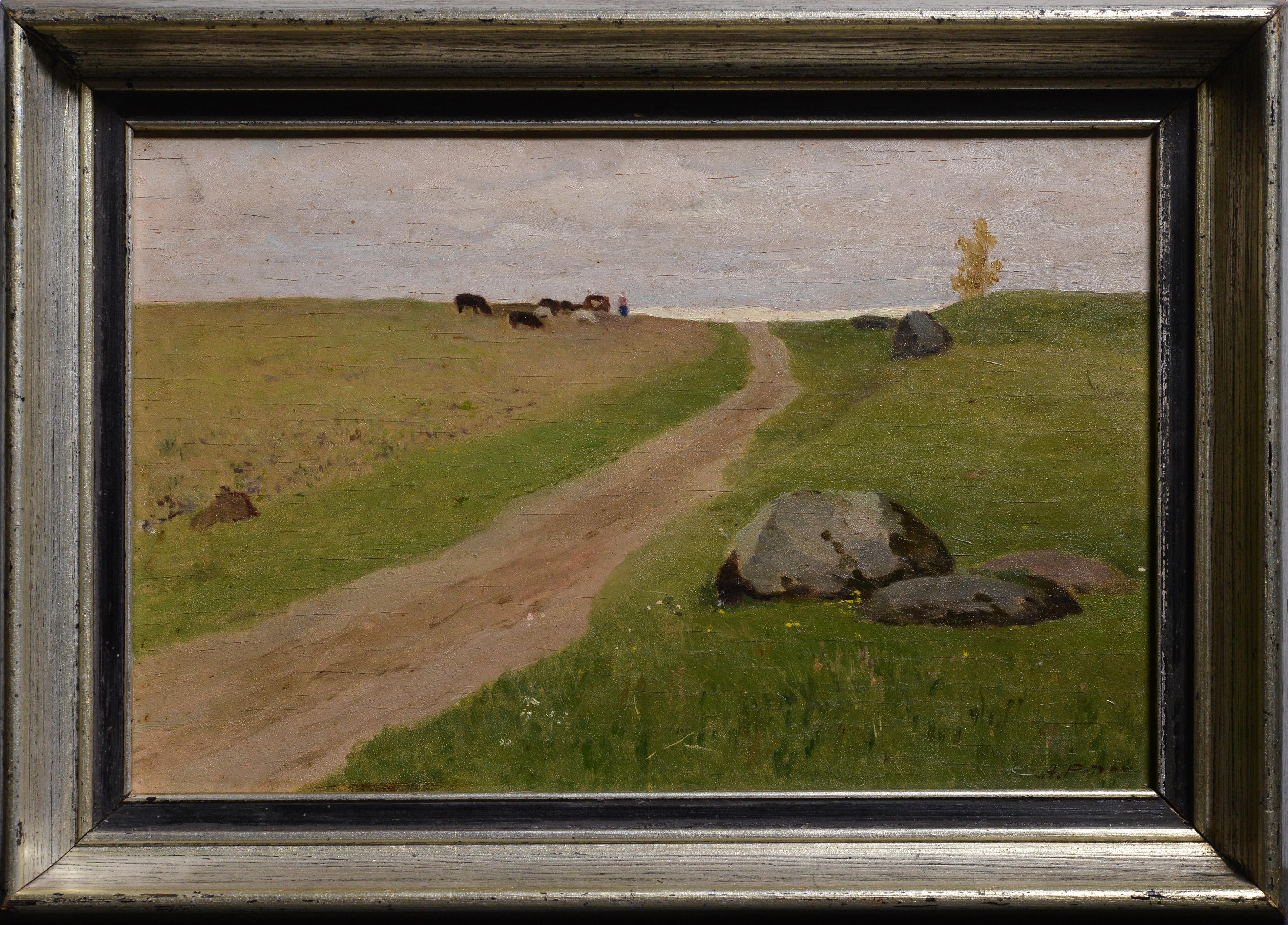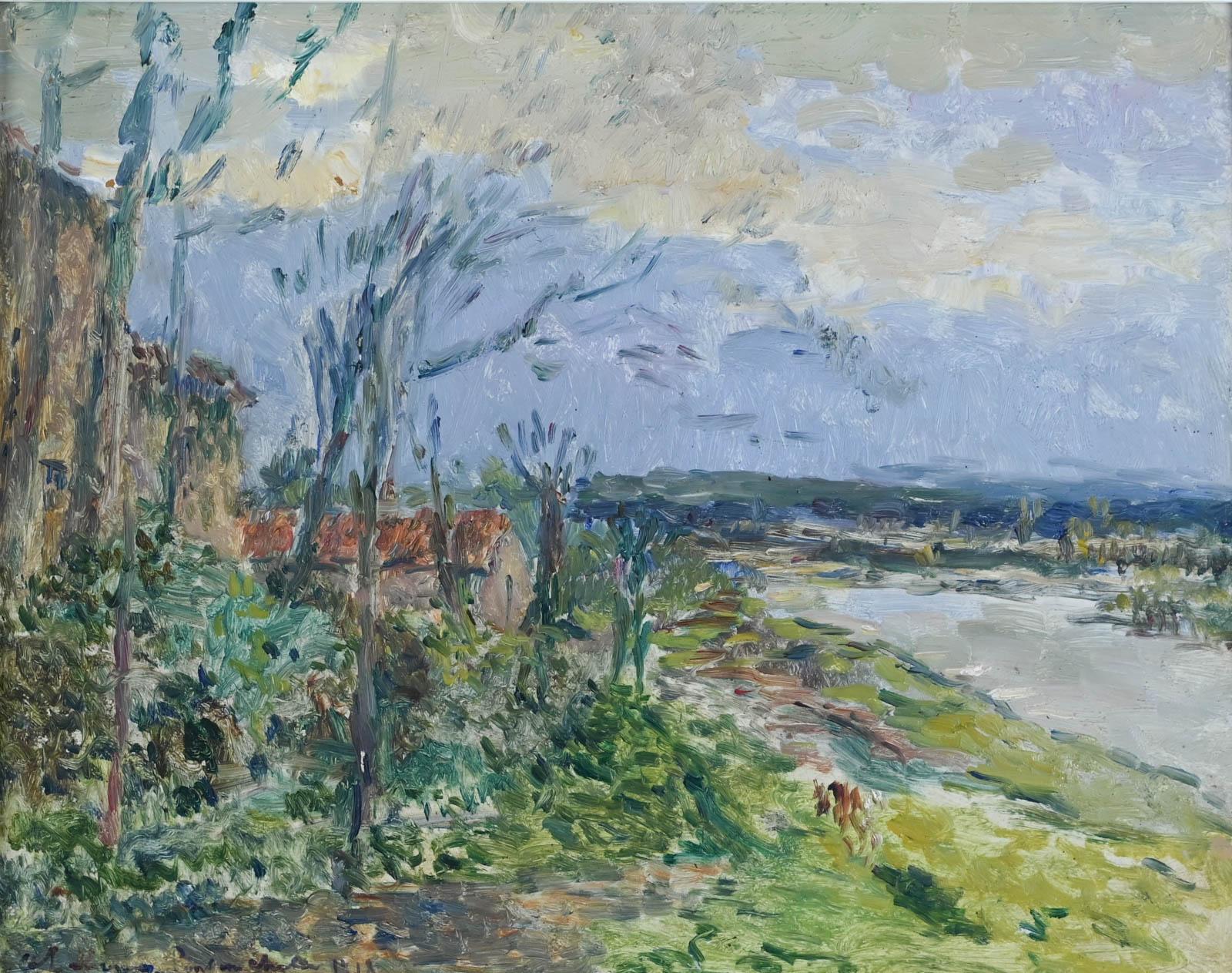Items Similar to " Summer Evening Southwest Texas " 1909 Texas Hill Country
Want more images or videos?
Request additional images or videos from the seller
1 of 8
Julian Onderdonk" Summer Evening Southwest Texas " 1909 Texas Hill CountryDated 1909
Dated 1909
About the Item
Julian Onderdonk "Summer Evening S. W. Texas" Texas Hill Country
(1882 - 1922)
San Antonio Artist
Image Size: 9 x 12
Frame Size: 15 x 18
Medium: Oil on panel
Dated 1909
"Summer Evening S. W. Texas"
"A Texas Painter Worked Under the Radar in New York," By Eve M. Kahn, March 6, 2014, The New York Times
Onderdonk, a San Antonio native who died of an intestinal ailment in 1922, at 40, is best known for painting swaths of Texas bluebonnets. Those canvases can bring more than $500,000 each, while his New York scenes usually end up in the five-figure range.
Onderdonk’s parents were painters in San Antonio, and in 1901, when he was a teenager, they sent him to New York for training. Through 1909, he lived in various Manhattan apartments and Staten Island houses. He then returned to Texas, but continued to spend months at a time in New York.
In 1902 he had married a Manhattan teenage neighbor, Gertrude Shipman. While she focused on raising their daughter, Adrienne, and worrying about their strained finances, “he created more than 600 works of art, often producing a painting or two a day,”
Eyewitnesses recorded his prolific pace in New York, but Onderdonk works bearing those dates rarely turn up. The puzzling gap in his productivity is explained in family correspondence that the Bakers uncovered: The artist admits that he was signing pieces with pseudonyms. He mostly used Chas. Turner and Chase Turner and occasionally resorted to Elbert H. Turner and Roberto Vasquez.
Julian Onderdonk was the son of the important Texas landscapist, Robert Onderdonk. He was the father's pupil at age 16. Sponsored by a Texas patron, he studied at the Art Students League in New York when he was 19, the pupil of Kenyon Cox, Frank DuMond, and Robert Henri. He also studied with William Merritt Chase on Long Island. In 1902, having lost his Texas patron because he married, he asked $18 for 12 paintings at a Fifth Avenue dealer in New York City, and was glad to accept $14 for the lot.
In 1909, Julian Onderdonk returned to the family studio in San Antonio. He painted "the bigness of Texas, dusty roads, the blooming cactus or hillsides of blue lupine, rolling gulf clouds, aged liveoaks, and the gray brush in winter. His style changed somewhat in his later years."
Onderdonk was heavy-set with dark eyes and hair, quiet and serious, "a strong personality." When he died at 40, "five of his pictures were on the way to New York. He also had orders ahead for $20,000 of work." He was known as the painter of the bluebonnet flowers of Texas.
- Creator:Julian Onderdonk (1882-1922, American)
- Creation Year:Dated 1909
- Dimensions:Height: 15 in (38.1 cm)Width: 18 in (45.72 cm)Depth: 4 in (10.16 cm)
- Medium:
- Movement & Style:
- Period:
- Condition:Great brush work and rare scene by Julian Onderdonk. Original Frame is spectacular. Please check our 1stdibs storefront for additional goodies.
- Gallery Location:San Antonio, TX
- Reference Number:1stDibs: LU76934771222
About the Seller
5.0
Vetted Seller
These experienced sellers undergo a comprehensive evaluation by our team of in-house experts.
Established in 1974
1stDibs seller since 2017
82 sales on 1stDibs
Typical response time: 1 hour
- ShippingRetrieving quote...Ships From: San Antonio, TX
- Return PolicyThis item cannot be returned.
More From This SellerView All
- "BLUEBONNETS IN BLOOM" TEXAS HILL COUNTRY FRAMED 22 X 26 BORN 1949 HEAVY IMPASTOBy Robert HarrisonLocated in San Antonio, TXRobert Harrison (Born 1949) San Antonio Artist Image Size: 16 x 20 Frame Size: 21.5 x 25.5 Medium: Oil on Canvas "Bluebonnets in Bloom" Biography Robert Harrison (Born 1949) Robert H...Category
Early 2000s Impressionist Landscape Paintings
MaterialsOil
- "A TEXAS TRAIL" TEXAS HILL COUNTRY FRAME 30 x 36 BLOOMING PRICKLY PEAR BORN 1949By Robert HarrisonLocated in San Antonio, TXRobert Harrison (Born 1949) San Antonio Artist Image Size: 24 x 30 Frame Size: 30 x 36 Medium: Oil on Canvas Dated 2010 "A Texas Trail" Hill Country Blooming Prickly Pear Cactus Biog...Category
20th Century Impressionist Landscape Paintings
MaterialsOil
- "OCTOBER SNOWS" G. HARVEY WESTERN GERALD JONES SNOW SCENE 22 X 19 FRAMEDBy G. HarveyLocated in San Antonio, TXG. Harvey (Gerald Harvey Jones) (1933-2017) San Antonio, Austin, and Fredericksburg Artist Image Size: 12 x 9 Frame Size: 22 x 19 Medium: Oil "October Snows" G. Harvey, known for paintings closely linked in mood and subject matter to Edouard Cortes [1882-1962], G Harvey creates romanticized street scenes of turn of the century towns in America. Rain slick streets reflect urban lights, and the weather is obviously cold. He grew up in the rugged hills north of San Antonio, Texas from where herds of longhorn cattle were once driven up dusty trails to the Kansas railheads. His grandfather was a trail boss at 18 and helped create an American legend for his grandson. So, the American West is not only the artist's inspiration but his birthright. Harvey's early interest in sketching and drawing slowly evolved into a passion for painting in oils. After graduating cum laude from North Texas State University, Harvey took a position with the University of Texas in Austin, but he soon realized that weekends and nights at the easel did not satisfy his love of painting. He abandoned the security of a full-time job in 1963 and threw his total energy into a fine art career. Harvey paints the spirit of America from its western hills and prairies to the commerce of its great cities. His original paintings and bronze sculptures are in the collections of major corporations, prestigious museums, the United States government, American presidents, governors, foreign leader and captains of industry. The Smithsonian Institution chose Harvey to paint The Smithsonian Dream, commemorating its 150th Anniversary. The Christmas Pageant of Peace commissioned Harvey to create a painting celebrating this national event. He has been the recipient of innumerable awards and the subject of three books. Today, G. Harvey lives in Fredericksburg, Texas, with his wife Pat in a 150-year-old stone home built by German settlers. His studio and residence are nestled within the Historic District of Fredericksburg. It is obligation of fine artists to present us with more than pretty pictures. They must also make us feel. Among the western painters of today, there is none more capable of accomplishing this than G. Harvey. In his paintings, the viewer into only sees the physical elements of his subject, but also senses the mood that surrounds them. It is a remarkable aspect of fine art, which few artists are able to master. Gerald Harvey Jones was born in San Antonio, Texas, in 1933. His grandfather was a cowboy during the trail-driving era when legends grew up along the dusty trails north from Texas. Family stories of wild cattle and tough men were absorbed by a wide-eyed boy and became the genesis of G. Harvey's art. A graduate in fine arts at North Texas State University, Harvey taught full-time and painted nights and weekends for several years. It was through painting that he found his greatest satisfaction, and his native central Texas hill country provided the inspiration for most of his earliest work. With the development of his talent and the growth of his following, Harvey began to expand his artistic horizons. He left teaching and concentrated on a career in fine art. He sought the essence that is Texas and found it not only along the banks of the Guadalupe, but in cow camps west of the Pecos, and in the shadows of tall buildings in big Texas cities. The streets of Dallas once echoed with the sound of horse's hooves and the jingle of spurs. Historic photographs reveal what it looked like, but only an artist like Harvey can enable a viewer to experience the mood and flavor or the time. Contemporary west art has too often centered on the literal representations from its roots in illustrations. Artists like G. Harvey take us a step further, to the subjective impressions that are unique to each great talent, and which constitutes something special and basic to fine art expression. Harvey is a soft-spoken and unassuming man who cares deeply about what he paints without becoming maudlin or melodramatic. We sense there is more in each Harvey painting than just that which is confined to the canvas. Resources include: The American West: Legendary Artists of the Frontier, Dr. Rick Stewart, Hawthorne Publishing Company, 1986 Artist G. Harvey grew up in the rugged hills north of San Antonio, Texas from where herds of longhorn cattle were once driven up dusty trails to the Kansas railheads. His grandfather was a trail boss at 18 and helped create an American legend. So, the American West is not only the artist's inspiration but his birthright. Harvey's early interest in sketching and drawing slowly evolved into a passion for painting in oils. After graduation cum laude from North Texas State University, Harvey took a position with the University of Texas in Austin, but he soon realized that weekends and nights at the easel did not satisfy his love of painting. He abandoned the security of a full-time job in 1963 and threw his total energy into a fine art career. Two years as a struggling artist followed, but 1965 brought acclaim for the artist's first prestigious show, The Grand National exhibition in New York, and the American Artists' Professional League presented him with their New Master's Award. President Lyndon Johnson discovered his fellow Texan's talent, became a Harvey collector and introduced John Connally to the artist's work. Connally was enthusiastic about Harvey's art, and, on one occasion, he presented a G. Harvey original to each governor of Mexico's four northern states. Harvey paints the spirit of America from its western hills and prairies to the commerce of its great cities. His original paintings and bronze sculptures are in the collections of major corporations, prestigious museums, the United States government, American presidents, governors, foreign leader and captains of industry. The Smithsonian Institution chose Harvey to paint The Smithsonian Dream commemorating its 150th Anniversary. The Christmas Pageant of Peace commissioned Harvey to create a painting celebrating this national event. He has been the recipient of innumerable awards and the subject of three books. Through his art, our history lives. Today, G. Harvey lives in Fredericksburg, Texas, with his wife Pat in a 150-year-old stone home built by German settlers. His studio and residence are nestled within the Historic District of Fredericksburg. Gerald Harvey Jones, better known as G. Harvey, grew up in the Texas Hill Country listening to his father and grandfather tell stories about ranch life, frontier days in Texas, and driving cattle across the Red River. Early in his career, he began to draw inspiration from that collective memory for paintings that would eventually earn him the reputation as one of America's most recognized and successful artists. His art is rooted in the scenic beauty of the land he grew up in and the staunch independence of the people who live there. He says, "My paintings have never been literal representations. They are part first-hand experience, and part dreams generated by those early stories I heard. They are a product of every place I have been, everything I have ever seen and heard." G. Harvey graduated from North Texas State University. He taught in Austin, but continued to study art in his spare time, eventually devoting full time to his painting. The year 1965 was a turning point when he won the prestigious New Masters Award in the American Artist Professional League Grand National Exhibition in New York. It is often said that in viewing a work of art, one is granted a unique look into the thoughts and expressions of values that give meaning to the artist work. Nowhere does this ring truer than the art of G. Harvey. Though Harvey has had nearly two decades of sell-out shows, an outstanding honor came with a series of one-man shows in Washington, D.C. in 1991. The first was at the National Archives featuring his paintings of the Civil War era, then a selection of paintings of notable Washington landmarks was exhibited at the Treasury Department, culminating in a one-man show of 35 paintings at the Smithsonian Institution during their exhibition of The All-American Horse. His work was featured in Gilcrease Museum exhibitions from 1992-1997. In 1987 his alma matter...Category
Late 20th Century Impressionist Landscape Paintings
MaterialsOil
- "Down By The Rio Grande" Texas Cowboy Western SceneLocated in San Antonio, TXFred Darge (1900-1978) Dallas Image Size: 24 x 30 Frame Size: 32 x 38 Medium: Oil, "Down By The Rio Grande" Biography Fred Darge (1900-1978) Friedrich Ernst Darge Born: March 1 1900 Rendsburg, Germany Died: April 10 1978 Dallas, Texas Entered the U.S. ; Jan. 14 1923 at Port Arthur, Texas. By 1924 he was in Chicago painting under the W.P.A. Artists policy and attending the Art Institute of Chicago from where he graduated. While in Chicago he painted and made model sail boats...Category
1940s Impressionist Landscape Paintings
MaterialsOil
- "VESPERS" TEXAS HILL COUNTRY FORESTLocated in San Antonio, TXBarbara Mauldin Fredericksburg Artist Image Size: 12 x 16 Frame: 16 x 20 Medium: Oil "Vespers" Barbara and her husband Chuck moved to Fredericksburg in 2005 after living many years in Louisiana, where she taught art at Baton Rouge Lutheran School. Soon after moving home to Texas, she began painting seriously. She has studied with Ian Roberts, Kevin Macpherson, Jill Carver, Lori Putnam, and (of course!) Chuck Mauldin. Barbara’s work has been accepted in several art events, such as the Women Artists of the West National Show, Contemporary Masters Invitational Art Show in Fredericksburg, the Mountain Oyster Club Art Show, the Plein Air Artists Colorado National Juried Art Exhibition, The Museum of Western Art (Kerrville, TX) “The Party” Art Exhibition and Sale, and others. Her paintings are characterized by color. “I like to emphasize the color that I see, as a creative and emotional response to the landscape.” She works with a limited palette, using a small number of pigments to mix colors, which results in beautiful color harmony. Barbara has focused her attention on the Texas landscape, especially on prickly pear cactus. Cactus is fun to paint. It has a multitude of interesting colors, which are an expression of the harshness of the environment and the amount of direct sun. In spring the colors are lighter and more mellow, and the flowers of late spring are a vibrant yellow and rose, sometimes orange. She enjoys plein air work, accepting the challenges of color, design, and the environment (critters and weather). Texas abounds with variety and inspiration; there is always another painting just around the corner! Her interest in art had always been a part of the fabric of her life. She works mainly in oil, and she also dabbles in pastels, watercolor, church banner...Category
20th Century American Impressionist Landscape Paintings
MaterialsOil
- "LUPES, WHITE HORSE" SOUTH OF TAOS, RIO GRANDE RANCHLocated in San Antonio, TXRoss Stefan (1934-1999) Arizona / Wisconsin Artist Image Size: 16 x 22 Frame Size: 25 x 31 Medium: Oil "South of Taos, New Mexico. Rio Grande Rancho, Lupe'...Category
20th Century Impressionist Animal Paintings
MaterialsOil
You May Also Like
- Ralph R. Stubbs - Low tide at Sunset - English 19th Century Marine Oil PaintingBy Ralph Reuben / Ruben StubbsLocated in Meinisberg, CHRalph Reuben/Ruben Stubbs (English, 1824-1879) Low Tide at Sunset • 19thC Oil on artist board (card) ca. 21 x 36.5 cm • Signed bottom right and verso Biografie: Stubbs Ralph Reu...Category
1860s Impressionist Landscape Paintings
MaterialsOil, Cardboard
- Peasant woman at work in the fields of CapriBy Charles Caryl ColemanLocated in Roma, RMCharles Caryl Coleman (Buffalo 1840 – Capri 1928), Peasant woman at work in the fields of Capri (1901) Oil painting on canvas 35 x 49 cm, signed, located and dated Capri 1901 lower ...Category
Early 1900s American Impressionist Landscape Paintings
MaterialsCanvas, Oil
- NewgardenLocated in Kennett Square, PANEWGARDEN 24”x36” Oil on board-mounted, oil primed linen Unframed 2021Category
2010s Impressionist Landscape Paintings
MaterialsOil
- American Winter Landscape 1951 Vintage Oil Painting by Impressionist MasterLocated in Stockholm, SEPeter Kurbatov (1907 – 1985), was a talented painter, graphic artist and writer. He lived a truly eventful life full of creative exploration. Despite the fact that this landscape was...Category
1950s Impressionist Landscape Paintings
MaterialsWood, Oil, Cardboard
- Latvian Pastoral Field Landscape by Petrovs first half 20th century Oil PaintingLocated in Stockholm, SEAttributed by Aleksandrs Petrovs (1874-1956). This fine painting depicts a serene Latvian pastoral landscape, with a winding road leading to the horizon through endless fields. Immer...Category
Mid-20th Century Impressionist Landscape Paintings
MaterialsWood, Oil
- Pont du ChâteauBy Albert LebourgLocated in LE HAVRE, FRAlbert LEBOURG (1849-1928) Pont du Château, 1918 Oil on panel Size : 33 x 42 cm Signed and dated 1918 lower left. Origin : - Galerie Tuffier, Les Andelys, - Private collection, Pa...Category
1910s Impressionist Landscape Paintings
MaterialsOil, Panel




